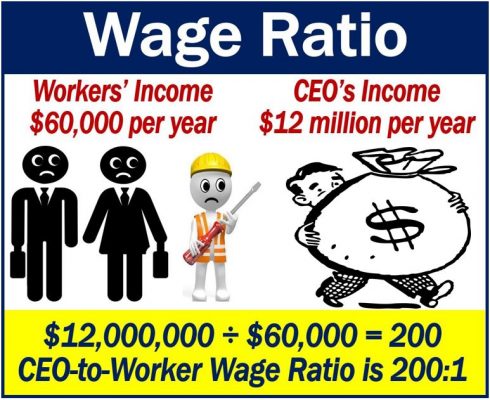What is wage ratio? Definition and examples
Wage ratio or pay ratio is the ratio of the top salaries to the bottom salaries. In other words, how much bigger the income of a company’s top executives are than those its workers. If a CEO earns $10 million per year and the average worker earns $50,000, what is the wage ratio? It is 200:1 ($10,000,000 ÷ $50,000 = 200).The term may also refer to a city, country, or whole region.
Wikipedia has the following definition of the term:
“In economics, the wage ratio refers to the ratio of the top salaries in a group (company, city, country, etc.) to the bottom salaries. It is a measure of wage dispersion.”
Wage ratio is part of the umbrella term income distribution.
CEO-to-worker wage ratio
According to Glassdoor.com, a job search website, the CEO-to-worker wage ratio in the USA in 2015 was 204:1. In other words, the average CEO pay was 204 times the average worker pay. CEO pay averaged $13.8 million per year, while that of workers was $77,800.

A study by two UC Berkeley researchers found that the CEO-to-worker wage ratio was 361:1 according to the most recent SEC filings. SEC stands for the US Security and Exchange Commission.
The SEC requires public companies to disclose their CEO-to-worker wage ratios. A public company is one whose shares members of the public can buy and sell on a stock exchange.
The two researchers also found that companies with a large CEO-to-worker wage ratio were not popular. They were less desirable to work for. They were also less desirable to buy things from, more than 1,000 study participants revealed.
Do not confuse the term with pay gap or wage gap, which usually refers to the average difference in pay between working men and women. Pay gap or wage gap may also refer to the differences in pay between ethnic groups.
US wage ratio nearing pre-financial crisis levels
Since the Global Financial Crisis of 2007/8, American CEO incomes have risen considerably faster than those of their workers.
The disparity has gotten significantly worse since President Donald Trump’s 2016 election. According to Fortune Magazine, in 2017, American CEOs enjoyed a 17.6% rise in income. Their workers, on the other hand, saw their paychecks increase in value by just 0.3% during the same period.
The widening CEO-to-worker wage ratio in 2017 occurred for two reasons: 1. CEOs cashed out stock options. 2. CEOs were awarded a very high value of stocks.

